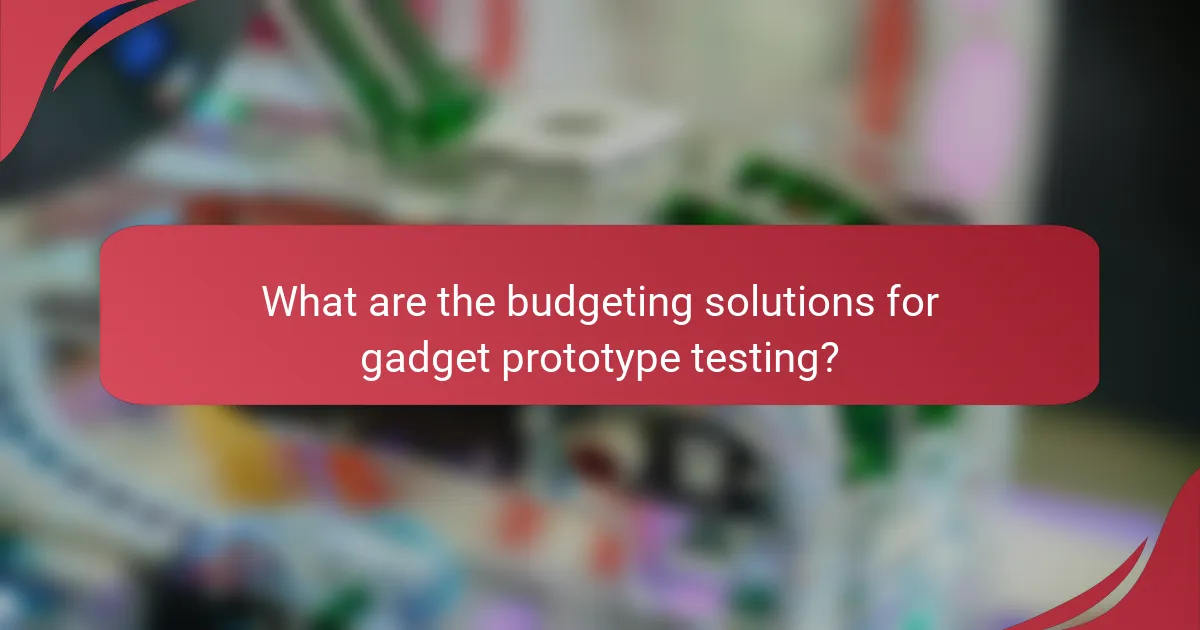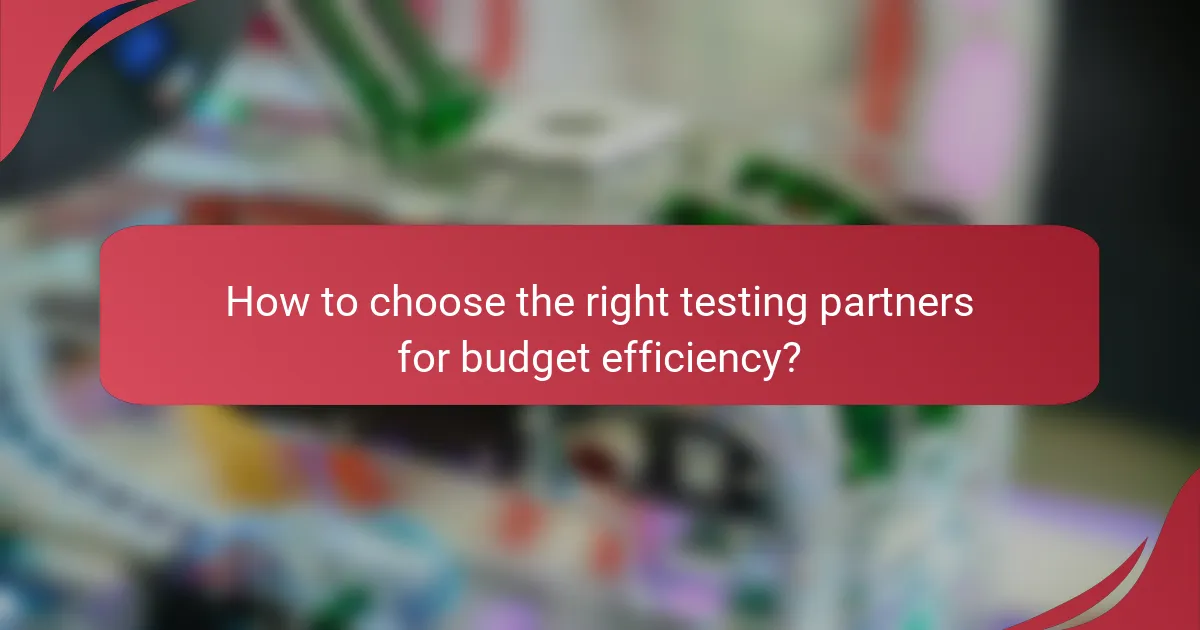Budgeting for gadget prototype testing is crucial for balancing quality and cost-effectiveness. By identifying key expenses such as materials, labor, and testing methods, innovators can create a financial plan that minimizes unexpected costs while maximizing the potential for successful outcomes. Understanding the complexities involved in the design and testing process further aids in effective resource allocation.

What are the budgeting solutions for gadget prototype testing?
Budgeting for gadget prototype testing involves identifying cost-effective strategies that minimize expenses while ensuring quality. Solutions include using affordable materials, outsourcing to experts, leveraging crowdfunding, applying for government grants, and adopting agile testing methods.
Cost-effective materials
Using cost-effective materials is crucial for keeping prototype testing within budget. Consider alternatives like recycled plastics or low-cost composites that can mimic the properties of more expensive materials without sacrificing functionality.
Additionally, sourcing local materials can reduce shipping costs and lead times. Always evaluate the trade-offs between cost and performance to ensure the prototype meets necessary standards.
Outsourcing to specialized firms
Outsourcing prototype testing to specialized firms can be a smart move for managing costs. These firms often have established processes and equipment that can reduce development time and expenses compared to in-house testing.
When selecting a firm, compare quotes and services to find the best fit for your budget. Ensure that the firm has experience in your specific gadget category to avoid costly mistakes during the testing phase.
Utilizing crowdfunding platforms
Crowdfunding platforms can provide a viable funding source for gadget prototype testing. By presenting your idea to potential backers, you can raise the necessary funds to cover testing costs while also validating market interest.
Platforms like Kickstarter or Indiegogo allow you to set funding goals and offer rewards to backers, which can motivate contributions. Keep in mind that successful campaigns require effective marketing and a compelling pitch.
Leveraging government grants
Government grants can significantly offset the costs of gadget prototype testing. Many countries offer funding programs aimed at fostering innovation and technology development, which can be a valuable resource.
Research available grants in your region, such as those from the Small Business Administration in the U.S. or similar entities in Europe. Be prepared to meet specific criteria and submit detailed proposals to secure funding.
Implementing agile testing methods
Agile testing methods focus on iterative development and rapid feedback, which can save both time and money. By testing prototypes in short cycles, you can identify issues early and make necessary adjustments without extensive rework.
Consider using techniques like user testing and A/B testing to gather insights quickly. This approach not only reduces costs but also enhances the final product by aligning it more closely with user needs.

How to estimate costs for gadget prototype testing?
Estimating costs for gadget prototype testing involves analyzing material, labor, and equipment expenses. A clear understanding of these components helps in budgeting effectively and avoiding unexpected financial burdens.
Breakdown of material costs
Material costs are often a significant portion of the prototype testing budget. This includes raw materials, components, and any specialized parts needed for the gadget. Depending on the complexity, material costs can range from a few hundred to several thousand USD.
When estimating, consider sourcing options. Bulk purchasing or using alternative materials can reduce expenses. Always factor in shipping and handling fees, which can add to the overall cost.
Labor cost estimation
Labor costs encompass the wages of engineers, designers, and technicians involved in the prototype testing process. These costs can vary widely based on expertise and location, typically ranging from $25 to $150 per hour.
To manage labor costs effectively, define clear roles and responsibilities. Hiring freelancers or part-time workers for specific tasks can be more cost-effective than employing full-time staff. Keep track of hours worked to avoid budget overruns.
Equipment rental fees
Equipment rental fees can significantly impact the budget for gadget prototype testing. Renting specialized tools or machinery may cost anywhere from $50 to $500 per day, depending on the equipment’s complexity and demand.
Consider the duration of the testing phase when estimating these fees. If possible, negotiate rental terms or look for package deals that include multiple pieces of equipment. Always assess whether purchasing equipment outright could be more economical in the long run.

What factors influence the budget for prototype testing?
The budget for prototype testing is influenced by several key factors, including the complexity of the design, the testing methods employed, and the location of testing facilities. Understanding these elements can help in accurately estimating costs and ensuring effective resource allocation.
Complexity of the design
The complexity of a prototype’s design significantly impacts the testing budget. More intricate designs often require advanced testing methods and specialized equipment, which can drive up costs. For example, a simple electronic device may only need basic functionality tests, while a sophisticated wearable gadget might require extensive usability and durability assessments.
When budgeting, consider the number of iterations needed for testing. Complex designs may necessitate multiple rounds of testing to refine functionality, which can add to overall expenses. A good rule of thumb is to allocate a larger portion of the budget for designs that involve advanced technology or intricate components.
Testing methods used
The choice of testing methods directly affects the budget for prototype testing. Common methods include usability testing, performance testing, and environmental testing, each with varying costs. For instance, usability testing may require user recruitment and compensation, while performance testing might involve expensive equipment and software.
It’s essential to evaluate the necessary methods based on the prototype’s intended use and target market. Prioritizing the most critical tests can help manage costs effectively. Consider using a mix of in-house testing and outsourced services to balance quality and budget constraints.
Location of testing facilities
The location of testing facilities plays a crucial role in determining the budget. Testing in regions with high labor costs or specialized facilities can significantly increase expenses. For example, conducting tests in major cities like New York or London may be more expensive than in smaller towns or countries with lower operational costs.
When selecting a location, consider both the cost and the availability of necessary resources. If possible, look for local facilities that offer competitive pricing without compromising on quality. Additionally, factor in travel expenses if testing requires transporting prototypes or personnel to different locations.

What are the best practices for managing prototype testing budgets?
Effective management of prototype testing budgets involves setting clear financial parameters, conducting regular reviews, and prioritizing testing phases. These practices help ensure that resources are allocated efficiently and that testing remains aligned with project goals.
Setting a clear budget framework
Establishing a budget framework is crucial for prototype testing. Begin by defining the overall budget based on project scope, expected outcomes, and available resources. Consider allocating funds for various aspects such as materials, labor, and equipment, ensuring that each category has a designated amount.
For instance, if your total budget is around $10,000, you might allocate 40% for materials, 30% for labor, and 30% for testing equipment. This structured approach helps in tracking expenses and making adjustments as needed.
Regular budget reviews
Conducting regular budget reviews is essential to stay on track. Schedule reviews at key project milestones or monthly to assess spending against the budget. This allows for early identification of any discrepancies and provides an opportunity to reallocate funds if necessary.
During these reviews, compare actual expenses with projected costs. If you find that testing costs are exceeding expectations, consider whether adjustments to the testing process or scope are needed to avoid overspending.
Prioritizing testing phases
Prioritizing testing phases helps manage budget constraints effectively. Break down the testing process into distinct phases, such as initial concept validation, user testing, and final adjustments. Allocate budget portions to each phase based on their importance and impact on the overall project.
For example, you might allocate 50% of your budget to initial testing to gather critical feedback early on, while reserving 30% for final adjustments. This strategy ensures that funds are directed where they will have the most significant effect on product development.

How to choose the right testing partners for budget efficiency?
Selecting the right testing partners is crucial for maintaining budget efficiency in gadget prototype testing. Focus on vendors that align with your financial constraints while delivering quality results, ensuring that you balance cost with the necessary expertise and resources.
Evaluating vendor pricing models
Understanding vendor pricing models is essential for effective budgeting in prototype testing. Common models include fixed pricing, time and materials, and performance-based pricing. Each has its advantages and disadvantages, so consider what aligns best with your project needs.
For instance, fixed pricing can provide predictability, making it easier to manage costs, while time and materials may offer flexibility but can lead to budget overruns if not monitored closely. Performance-based pricing can incentivize quality but may require more negotiation and clarity on deliverables.
When evaluating pricing, request detailed quotes and compare them against the services offered. Look for hidden costs, such as additional fees for revisions or expedited services, to avoid surprises. A checklist of key factors to compare can include pricing structure, included services, and past performance metrics.


